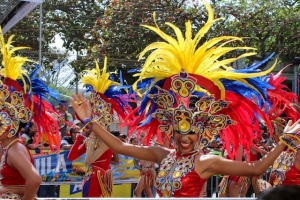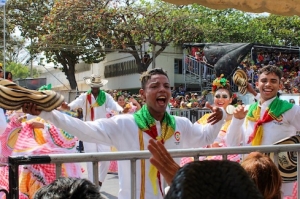
The following post was written by Global Gap Year Fellow Simone McFarlane. Simone spent the second half of her Gap Year in Barranquilla, Colombia.
The Carnaval of Barranquilla is the biggest cultural event in Colombia and the second biggest Carnaval in the world. Considered to be an Intangible Cultural Heritage of Humanity, the Carnaval of Barranquilla is celebrated by over 2 million people each year. The celebration can be traced back to European traditions, which have in turn been enriched by African and Indigenous cultural practices. Today, Carnaval is celebrated with a large array of dances, music, festivals, and parties.

Carnaval was always one of the reasons why I was so excited to go to Barranquilla. I arrived a month before the main events, but the spirit of the Carnaval was still evident all across the city. People had posted colorful decorations outside their homes, weekly dance showcases gained hundreds of spectators, and advertisements for the upcoming festivals were everywhere. I knew the events that were to come, but I had no idea about how elaborate they were going to be. Slowly, as February 22 neared closer, more and more travelers came to the city. This was very interesting to see, as before this day Sarah and I hadn’t met any other foreigners in town. I quickly learned that I should’ve researched more about the events’ logistics. For whatever reason, it hadn’t even crossed my mind to get tickets for the Queen’s coronation or the festival. Saving everything for the last minute proved to be expensive, so I’d definitely advise people to have their ducks in a row before. I subsequently missed the Queen’s coronation, but I think I would’ve had to pay a lot for good seats anyway, and that certainly wouldn’t be in my 9-month gap year budget. We got last minute tickets to the Batalla de Flores, which was spectacular. The floats, the dancers, the music, the party spirit was amazing to see. To be honest, however, we didn’t have a great view and the day was really long, and there was no clear exit, so we had to escape through the festival. That was probably one of the most embarrassing and stressful moments of my life, but looking back it was pretty funny to think of all the people yelling at us to dance.

Later that day was my favorite experience of Carnaval. My friend Jack and I went to the Baila La Calle, which was a humongous street party in the historic birthplace of Carnaval. We happened to run into other friends from Cartagena, and the rest of the night was so much fun. Everyone was so friendly and in a festive mood. We stayed out almost all night and then woke up the next morning tired, but excited to do it again…Or so we thought. The second day was the Gran Parada de Tradición y Foclor. We had much better seats this day; we had a better view and we weren’t dying in the heat. It was cool to see all the dances and floats, but by this point, we realized that we preferred the street parties much more. The street parties were open to everyone, so the crowd was significantly more diverse and joyous. The festivals were fantastic, but you could kind of tell that it had been commercialized for the incredible number of tourists that come each year (at least, that was my impression). We went to the Baila La Calle again, but we were exhausted by that point. If I ever get the chance to go back to the Carnaval of Barranquilla, I would definitely budget my energy for the street parties as opposed to the day festivals.
I’m so grateful that I had the opportunity to experience such a monumental celebration. The whole experience taught me so much about Colombia’s diverse history and culture. It has also given me more interest in studying how tourism has affected marginalized cultures, as Carnaval was largely created by communities of color but now the main events are prohibitively expensive for many of these communities.
Please enjoy my pictures that capture a grain of the excitement of the Carnaval of Barranquilla!
